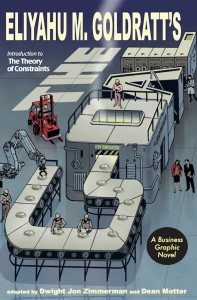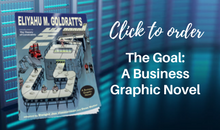 Eli Goldratt’s management classic The Goal, a staple in business schools around the world, has been adapted as a graphic novel. Graphic novels are an innovative way for a visually-oriented generation of students to learn business concepts, test their management acumen, predict outcomes, think creatively, and at the same time feel fully engaged in—even excited about—both the material and its lessons.
Eli Goldratt’s management classic The Goal, a staple in business schools around the world, has been adapted as a graphic novel. Graphic novels are an innovative way for a visually-oriented generation of students to learn business concepts, test their management acumen, predict outcomes, think creatively, and at the same time feel fully engaged in—even excited about—both the material and its lessons.
Concept pioneered at Harvard Business School
Harvard Business School first introduced the graphic novel, an adaptation of a classic business case study, to its curriculum in 2009. Graphic novels have since earned a legitimate place on syllabi and library shelves, as educators have recognized their value in teaching today’s visually oriented students. Professors at Harvard and elsewhere now use graphic renderings of case studies, as well as fully-developed graphic textbooks, to teach business concepts.
Benefits of the graphic format
Creativity
While it may seem a strange bedfellow to the analytical nature of the business curriculum, the graphic novel format injects a most sought-after skill into any business program: creativity. Its visually energetic style invites the reader directly into the heart of the material, encouraging them to interpret, imagine and make predictions. These are precisely the skills that will make the student a successful leader in the real-life business world.
Accessibility
The power of the graphic format lies in its engaging imagery and text. Illustrated panels show how the players in the situation look: their facial and physical reactions. For students whose first language is not English, and for those who learn best with visual cues, the pictorial narrative synthesizes information through more accessible channels.
Engagement and retention
Professors who have assigned graphic novels have reported increased student participation and attendance rate. Furthermore, research published in Business Communica0on Quarterly found that students who read a graphic novel about management concepts were far better at identifying specifics in the material afterward than those who had read the traditional textbook version. Why these improved results? When the material is interesting, appealing and engaging, we pay more attention. Visual information is also processed and stored more quickly and efficiently by the brain than non-visual content, so when it draws on more than one of our paths of cognition, it stays with us: think of the tune to which we are taught the alphabet, or the pictorial formats used to communicate goals and improve outputs.
Learn more about The Goal: A Business Graphic Novel. To request a desk copy, contact Amy Gallagher.






